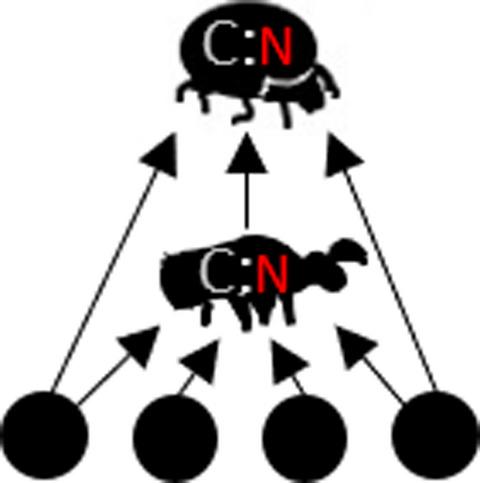当前位置:
X-MOL 学术
›
Funct. Ecol.
›
论文详情
Our official English website, www.x-mol.net, welcomes your
feedback! (Note: you will need to create a separate account there.)
Stoichiometric and structural uncertainty in soil food web models
Functional Ecology ( IF 4.6 ) Pub Date : 2020-10-19 , DOI: 10.1111/1365-2435.13706 Robert W. Buchkowski 1 , Zoë Lindo 1
中文翻译:

土壤食物网模型的化学计量和结构不确定性
更新日期:2020-10-19
Functional Ecology ( IF 4.6 ) Pub Date : 2020-10-19 , DOI: 10.1111/1365-2435.13706 Robert W. Buchkowski 1 , Zoë Lindo 1
Affiliation

|
- Soil food web models are a powerful tool for calculating the carbon and nitrogen mineralized by different soil organisms. Two limitations of the current models are that they use (a) fixed parameters for determining the relative efficiency of carbon and nitrogen conversion and (b) a generic set of trophic species (i.e. nodes).
- We propose a new method for analysing soil food webs that varies production efficiency and diet mechanistically with resource stoichiometry. Then, we calculated how the lumping or splitting of trophic species affects carbon and nitrogen mineralization for both net mineralization rates as well as the distribution of mineralization (i.e. sources of mineralization). Our models with additional stoichiometric details better represent organisms that consume basal resources with high C:N ratios.
- This is important because we show that lumping together trophic species at low trophic levels, which often differ in C:N ratios (i.e. microbial taxa), causes the largest deviations in estimates of carbon and nitrogen mineralization. One reason for the large effect of C:N ratio is that it impacts diet and production efficiency in our stoichiometric model. Conversely, lumping together species at higher trophic levels causes the largest errors when those species have different production and assimilation efficiencies. Finally, we demonstrate that differences in death rate and biomass are mostly important when lumping species that have different diets.
- We suggest that C:N ratios are especially important when grouping microbial taxa because microbial C:N ratios vary widely and microbes feed at low trophic levels where differences in C:N ratio mattered the most. Conversely lumping higher consumers will be most problematic when they have differences in the conversion efficiencies. We provide an approach to calculate structural error and report it with parameter uncertainty. Then, we demonstrate, using oribatid mites as an example, that considering the life history of different taxa can help us group organisms more efficiently into trophic species. In doing so, we provide a way to reduce and report the uncertainty in soil food web models and to stimulate future empirical work measuring key life history parameters.
中文翻译:

土壤食物网模型的化学计量和结构不确定性
- 土壤食物网模型是计算不同土壤生物矿化的碳和氮的有力工具。当前模型的两个局限性在于它们使用(a)固定参数来确定碳和氮转化的相对效率,以及(b)一组通用的营养物种(即节点)。
- 我们提出了一种新的方法来分析土壤食物网,该方法通过资源化学计量来机械地改变生产效率和饮食。然后,我们计算了营养物种的结块或分裂对净矿化率以及矿化分布(即矿化源)的碳和氮矿化的影响。我们的模型具有更多的化学计量细节,可以更好地代表消耗高C:N比的基础资源的生物。
- 这很重要,因为我们表明,将低营养级别的营养物种聚集在一起通常会导致C:N比值不同(即微生物分类群),从而导致碳和氮矿化估算值的最大偏差。C:N比之所以会产生巨大影响,原因之一是它会影响我们的化学计量模型中的饮食和生产效率。相反,将具有较高营养级别的物种混在一起会导致最大误差,而这些物种的生产和吸收效率不同。最后,我们证明了当集聚不同饮食的物种时,死亡率和生物量的差异最重要。
- 我们建议在对微生物分类群进行分组时,C:N比尤为重要,因为微生物C:N比变化很大,并且微生物以低营养水平进食,其中C:N比的差异最重要。相反,当高效率的消费者在转换效率方面存在差异时,他们将成为最大的问题。我们提供了一种计算结构误差并报告参数不确定性的方法。然后,我们以鸟栖螨为例,证明考虑到不同分类单元的生活史可以帮助我们将生物更有效地归为营养物种。为此,我们提供了一种方法来减少和报告土壤食物网模型中的不确定性,并刺激未来的测量关键生命历史参数的实证工作。











































 京公网安备 11010802027423号
京公网安备 11010802027423号